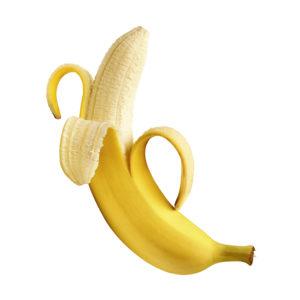 Other than their distinctive colour, one of the other notable aspects of bananas is that they come ready-packed in an easy-peel wrapper and has endured no human intervention on the inside.
Other than their distinctive colour, one of the other notable aspects of bananas is that they come ready-packed in an easy-peel wrapper and has endured no human intervention on the inside.
Bananas are known to be the most carby fruit, but apples and pears are not far behind so it’s no great crime. In addition, bananas are ‘complex carbohydrates’, which means that they have a low GI of 55 (they release what sugars they do contain slowly, thereby avoiding blood sugar spikes. In fact, a diabetic on insulin needs to be aware that their insulin dose might absorb and get to work before the carbs in the banana are digested. Anyone on a pump might consider a bolus type that covers a long period of time to match the slow release of the carbs contained in the banana.
There’s a considerable array of vitamins and nutrients contained within. They are packed full of some goodies – one banana contains 10% of your daily potassium needs, 10% of your dietary fibre and 14% of the RDA of Vitamin C as well as a whopping 20% of your Vitamin B6 needs. Plus the carbs alone in one banana represent 7% of an adult’s daily requirement.
Nutrition content of bananas
Per 100g (a medium banana averages 120g)
89 calories
3g of fat
23g carbs
12g sugars
Under wraps
You are unlikely to lose weight on a banana diet, but fibre boosts satiety and helps with digestive health. Bananas are a heart-healthy food when included in a diet low in saturated fat and cholesterol. Potassium helps to reduce blood pressure and alleviates water retention and bloating.
Vitamin B6 helps the body produce haemoglobin, a component of blood, and helps with your body’s immune system and antibody production. It is also involved in the mechanisms that converts carbohydrates to glucose and therefore is a factor in blood glucose control. Bananas are also a good source of manganese, which is an antioxidant that is involved in regulating blood sugar levels.
Bananarama!
Edible bananas evolved from a plant in the Indo-Malaysian region and have been mentioned in literature as far back as the 6th century BC. Most bananas are now grown in tropical regions, like South America, Central America and the Caribbean so they do undertake quite a journey to get into your hands.
Other than just peeling and eating them, you can slip them into smoothies, slice up and scatter on your morning muesli, or bake and serve with cream, pan-fry and pop on a pancake, bake banana bread or mush into a muffin for extra oomph, wrap in bacon and slap them on the barbie.
Naughty but nice
If you want to make a healthy thing (a banana) less healthy, then you can bake in the oven. Just slit open the banana skin to save it from bursting open and put in a baking tray for 15-20mins at 180 degrees C (350F), then serve with some cream and a grind of nutmeg.
Top tips
1. Store away from sunlight, or they will ripen quickly.
2. Do not store in the fridge, or they will get brown spots.
3. Use overripe bananas in recipes (you can even freeze them to use later).
4. Use a ripe banana to ‘bring on’ other unripe fruits – put a ripe banana in a paper bag with the fruit, such as an unripe avocado) and leave a few days.
This news item first appeared in our free-to-receive online magazine. Go to the top of this page to sign up – we just need your email address.
Open publication



